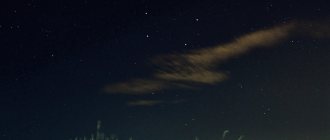Category: Astronomy for Dummies Published 02/02/2019 · Comments: 0 · Reading time: 4 min · Views: Post Views: 29,999
As you know, the Big Dipper is the most important star pattern in the sky of the Earth's northern hemisphere. This bucket is usually called the Big one. But besides it, there is also a Little Dipper , which belongs to the constellation Ursa Minor. (Did you know that it includes the North Star?) It would be nice to know the position of the Little Dipper in the sky, because it is located near the celestial pole, and therefore can serve as an excellent landmark in the sky! Let's see how to find Ursa Minor in the sky and how this knowledge will help us in orientation.
How to find Ursa Minor from Ursa Major?
Obviously, most of you will find Ursa Major with ease. She is quite expressive and bright. Knowing that both constellations are nearby, it will undoubtedly become clear how to find Ursa Minor from Ursa Major. To do this, you will need to mentally connect the last two stars of the Big Dipper: from Merak (β Ursa Major) to Dubha (α Ursa Major)), continuing this line upward to a distance 5 times greater than the distance between them. This is how you will discover Alpha (the North Star) of the Ursa Minor constellation.
Before wondering how to find the constellation Ursa Minor, knowing only the location of Polaris, you need to understand what figure the luminaries form, and how the asterisk is located relative to the Big Dipper.
For a complete understanding: according to their names, they are quite similar and resemble a ladle in shape. As for the location, Ursa Minor is practically in an inverted position relative to the Big Dipper.
Legends about the constellation Ursa Minor
In fact, stories about this celestial area are closely intertwined with legends about the Big Dipper . For example, in Greece it was believed that Ursa Major was the nymph Callisto, and Ursa Minor was her dog. However, there is another version of the appearance of the constellation. According to it, the seven stars of the region are the Hesperides (daughters of Atlas). They guarded the golden apples in Hera's garden. For which she thanked them by placing them in heaven.
Nymph Callisto (image)
Knowledge is power
Study the star map before starting your search, this will make it easier for you to find the asterisk. Subsequently, you will be convinced of the ease of detection of the desired star group. And if someone asks you how to find Ursa Minor from Ursa Major, you, with full knowledge of the matter, can clearly explain how to find it.
Well, now we know how to find the constellation Ursa Minor. Let's talk about the North Star, thanks to which travelers and sailors of the past made a long and difficult journey. Although this is not the brightest star in the night sky, it is located closest to the northern point of the world, the error does not exceed 1°. After only 145 years, the position error will exceed one degree.
Only after 3200 will the star closest to the northern point of the world become Alderamin (alpha Cephei).
Other objects
Perhaps, from the remaining components, a dwarf galaxy with a name similar to the constellation can be distinguished. It belongs to elliptical. What is important is that it is a satellite of the Milky Way. That is, our galaxy. Scientists have discovered the presence of the Ursid meteor shower .
Meteor shower (image)
In addition, the constellation has the Little Dipper . It is formed, of course, by the North Star, as well as Beta, Delta, Zeta, Eta, Epsilon and Gamma. It is noteworthy that the shape of the asterism resembles the Big Dipper. We can say that even in this, the constellation Ursa Minor is in many ways similar to the Big Sister.
"Twists" the bear by the tail on the earth's axis
The North Star does not change its position, despite the Earth's daily rotation around its own axis and annual movement in orbit around the Sun. The brightness of the guiding star is not constant and changes intensity every 4 days, within 2.02 ± 2%. Previously, the luminosity amplitude was higher, but today it has stabilized. The overall brightness of the North Star is constantly growing and has increased by almost 15% over the past hundred years.
The nature of the pulsation is related to the properties of the star; this is exactly how Cepheids behave. Guiding Star is one of the brightest Cepheids in the night sky. Ursa Minor occupies an area of about 255.9 square degrees in the sky. Its closest neighbors are the Dragon and Cepheus.
In the asterisk, as already mentioned, the North Pole of the World is located - the point of the celestial sphere where all objects revolve around it. The first mention in historical sources was made by the Greek astrologer Ptolemy in the 2nd century.
Ursa Minor and its stars
The Little Dipper constellation includes seven bright objects. Of all the luminaries of Ursa Minor, only the three brightest are clearly visible. These are Ferhad and Kohab, forming the wall of the Bucket, and crowning the handle of the constellation Polaris. The last two stars are located above the tail of Ursa Major.
The Little Dipper is somewhat different from other constellations. It does not change its location in the sky, like Ursa Major and most other asterisks, which are seasonal. They can be observed in certain seasons, and they are mobile in the sky throughout the year. Ursa Minor also changes its location, rotating around its Alpha.
Ursa Minor in the sky
Ursa Minor is located in the circumpolar region and is visible all year round in the northern hemisphere. Designated as Ursa Minor, or UMi. Its stars are arranged in such a way that they resemble a “bucket”, similar to the Big Dipper, but with a differently curved “handle”.
In the sky, Ursa Minor is in the north. The last star in its tail is Polaris, and it always stays in one place. Its height above the horizon in degrees is equal to the latitude of the observation location. Therefore, the North Star not only indicates the direction to the north, but also allows you to accurately determine one of its coordinates. This feature was noticed and used by the Phoenicians, thanks to which they had an advantage at sea for more than 1000 years.
Ursa Minor in the sky. Position as of January 1.
The rest of the Ursa Minor constellation can change its position throughout the year or day, as if rotating counterclockwise around the North Star. By the way, this constellation in the northern hemisphere is visible all year round, but in Russia it can be seen on any clear night, since it never goes beyond the horizon.
Next to the Little Dipper there is a much larger and more noticeable one - the Big Dipper. If you find it and draw a line through the two outermost stars in its “bucket”, you will get exactly to the North Star. This is the most famous and simplest way to find it, which can be shown to children.
In terms of size, Ursa Minor ranks 56th among all constellations, and occupies an area of only 256 square degrees in the sky.
"Alpha and Omega" constellation Ursa Minor in the northern hemisphere
Alpha (Pole Star) Ursa Minor is located 431 light years from Earth. With an apparent magnitude of 2.02. As it became known, this is not one, but three stars united into a single system. The brightest among them is almost 2 thousand times greater than the brightness of the Sun. The second luminary Ursa Minor has a mass equal to 1.39 solar.
It can be observed through a small telescope. The third Alpha star is 1.25 times more massive than our Sun and is located quite close to the first. With the help of the Hubble telescope, it became possible to view it as a separate star.
Kohab is an orange giant, translated from Arabic as “Star of the North”. The second brightest star, also known as beta, is in the constellation Little Dipper with a magnitude of 2.8 and is 126 light years away from Earth.
Ferhad is the gamma of Ursa Minor, with a magnitude of 3.6, the distance to it is 480 light years. This object is considered a hot giant with a temperature of 8600 K and belongs to the variable type of stars.
Delta Little Dipper, or Yildun, is a white dwarf star located 183 light years away.
Zeta is another dwarf, white in color and located 380 light years from Earth. The intensity of its glow is 200 times higher than that of the Sun. It is on the way to forming a giant star.
The brightest star in the constellation Ursa Minor
The brightest point in the sky appears so only to human eyes. In fact, there are many brighter objects. However, the North Star shines more spectacularly than the others. It is a supergiant and has two satellites.
The star itself is central, and its brightness exceeds the capabilities of the Sun by 2000 times. The existence of a second satellite became known not so long ago due to its size. The dwarf satellite has not been visible to the photographic lenses of telescopes from Earth for many years.
The sky is full of secrets and unknown mysteries
Even without a telescope, just looking at the night lights, you will see how diverse our large Universe is.
The constellation Ursa Minor is just a small visible part of it. The boundaries and dimensions of the Universe visible to us today have been determined. These are truly gigantic magnitudes, its extent is about 14 billion light years.
But is the Universe like this in reality? This thought excites the minds of great scientists. They build hypotheses, research, argue and try to understand whether this is true? Some experts express the opinion that the Universe is infinite, others that there is a Multiverse.
And it may well turn out that one of them contains the same planet, country and copy of you. Everything is possible, science constantly pushes back the veil of the unknown and hidden from our sight, invariably proving: what seems fantastic today comes true tomorrow.
Myths and legends about Ursa Major and Ursa Minor
The existence of constellations has been known for a very long time. Even before our era, they were guides for travelers. However, to the ancient Greeks they were more than just bright spots in the sky.
According to myths, the thunder god Zeus once had a secret lover. The story goes that she was famous for her unearthly beauty and attracted the gaze of all men. Her name was Callisto.
One day a girl broke the rules, her little mistake cost her dearly. She was turned into a terrible bear. Zeus, deciding to protect the beauty, threw her into the sky, and tried so hard that he stretched her tail. That is why it is now so long at the Big Dipper.
The girl's faithful companion was her dog, which was turned into a bear cub that followed her to heaven. The tale was common among the ancient Greeks.
The expanses of the starry sky can show many unusual things. You can even learn a lot of interesting things about the familiar bears. How many more unknown constellations are hidden in the vastness of space? Knowledge opens a window to a person into the world of our Universe.











